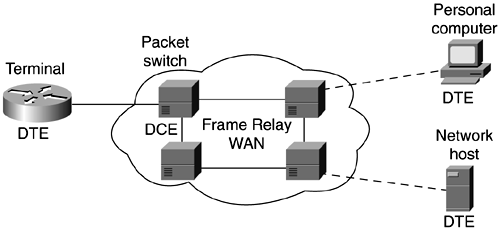Frame Relay Devices
Devices attached to a Frame Relay WAN fall into two general categories: data terminal equipment (DTE) and data circuit-terminating equipment (DCE). DTEs generally are considered to be terminating equipment for a specific network and typically are located on the premises of a customer. In fact, the customer can own them. Examples of DTE devices are terminals, personal computers, routers, and bridges.
DCEs are carrier-owned internetworking devices. The purpose of DCE equipment is to provide clocking and switching services in a network, which are the devices that actually transmit data through the WAN. In most cases, these are packet switches. Figure B-1 shows the relationship between the two categories of devices.
Figure B-1. DCEs Generally Reside Within Carrier-operated WANs

The connection between a DTE device and a DCE device consists of both a physical layer component and a data link layer component. The physical component defines the mechanical, electrical, functional, and procedural specifications for the connection between the devices. One of the most commonly used physical layer interface specifications is the recommended standard RS232 specification. The data link layer component defines the protocol that establishes the connection between the DTE device, such as a router, and the DCE device, such as a switch. This appendix examines a commonly utilized protocol specification used in WAN networkingthe Frame Relay protocol.
| |
| Top |
EAN: 2147483647
Pages: 127